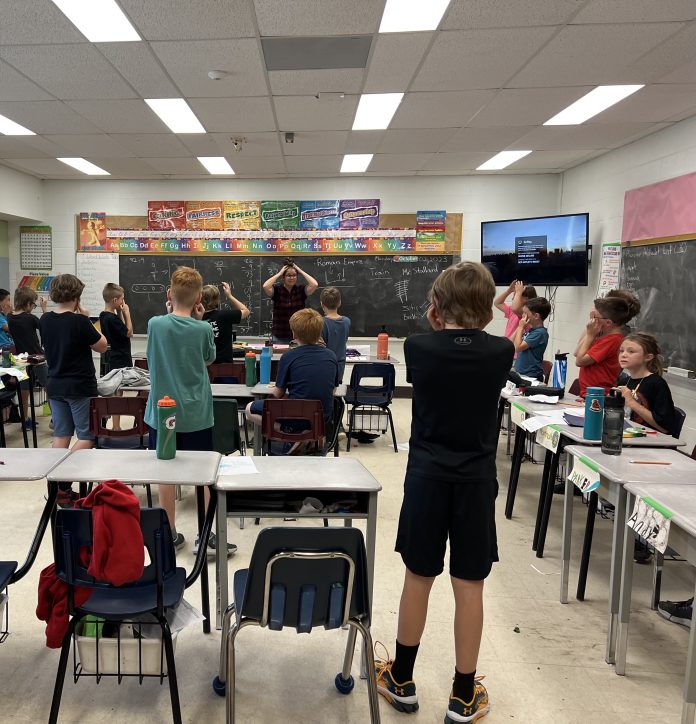
Working with researchers from Nipissing University, staff, students and families at Sundridge Centennial Public School (SCPS) are providing valuable data about student movement patterns – including physical activity, sedentary behaviour, and sleep – and their impact on mental health indicators. The results are benefitting students, families, and the school as they work on changes to everyday practices that enhance students’ ability to achieve.
SCPS Principal Jill Cooper has been working with Dr. Brenda Bruner and Dr. Barbi Law, professors at Nipissing University, whose areas of specialization are physical activity, psychological skills, health promotion, and community-based participatory research. Theirresearch interests are primarily related to physical activity and sport participation.
The Move More, Sit Less study gathers information about student activity levels throughout the entire day, not just during school. The goal of the project is to provide schools with a snapshot of students’ movement behaviours so the school community can identify opportunities and work with the research team to support healthy active living. Cooper stresses that the changes are “over and above our daily physical activity time, which is completed as a morning routine with the entire school population walking/jogging/running the perimeter of the playground for a period of 15 minutes, as per Ministry of Education mandates.”
Several initiatives have been adopted at SCPS as a result of this research to encourage students to move more in school. For example, wipe books and dry erase chart paper allow students to stand and solve problems using non-permanent vertical spaces.
Cooper says staff at SCPS were keen to help, as the research was about their students. There has been minimal disruption through the school day, as the body breaks are taking place in a natural point in the lesson.
In the fall of 2023, Bruner gave a presentation to educators, parent council and student parliament. She explained that through the research, she wanted to give back. Bruner felt that when people read studies, the data is collected in contexts that are different; she wanted to do research to add to research literature “by contributing to the context we’re in.” In other words, she wanted rural and northern data included in research literature. For example, she says rural students’ time spent sitting is increased because of the time they spend every day on school buses.
The purpose of Bruner and Law’s research is to improve children’s physical activity towards 24-hour movement guidelines, a shift away from physical activity just at school. “The whole day is important,” Bruner says. The guidelines for healthy children and youth aged 5-17 recommends at least 60 minutes per day of moderate to vigorous physical activity, several hours of a variety of structured and unstructured light physical activities, nine to 11 hours of sleep per night for children aged 5-13 and eight to 10 hours of sleep per night for those aged14-17, and no more than two hours of recreational screen time per day.
The research conducted at SCPS showed that students’ habits were good in some areas, but many had poor sleep or spent too much time sitting. The activity data was grouped by division (primary, junior, intermediate), which showed that older students spent less time in movement. Bruner and Cooper, along with the SCPS educator team, came up with ideas to encourage movement throughout the school day, which may have the added benefit of helping students to refocus on lessons.
Cooper says after the initial round of data collection, the staff started movement and body breaks. Staff have access to resources to learn to incorporate movement into their day. They noticed a significant change in the children’s ability to focus, so body breaks have been integrated into crucial parts of the day, so children can maintain attention and engage cognitive processes more efficiently.
The study is also helping students to improve their sleep by teaching them to be more mindful. The majority of students had some sort of screen in their rooms, and most students are hearing notifications through the night. Students are working at increasing self-regulation, when engaging in screen time.
The study will continue to develop initiatives that address the findings of the data and tackle them as a school; the SCPS parent advisory council encouraged parents to visit well-being information stations throughout their welcome back to school event in September of 2023, including sharing the valuable information collected and recommendations made by Dr. Bruner and Dr. Law.
SCPS student parliament has supported this endeavour by using the data shared to plan and implement a “sleep week” initiative. Students who track their sleep goals over the week of June 17-21, 2024 are invited to a PJ and movie celebration on June 21, with the hopes students will value the importance of getting nine to 11 hours of sleep daily.







